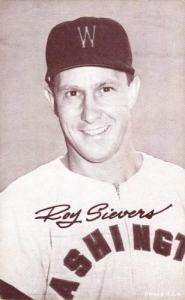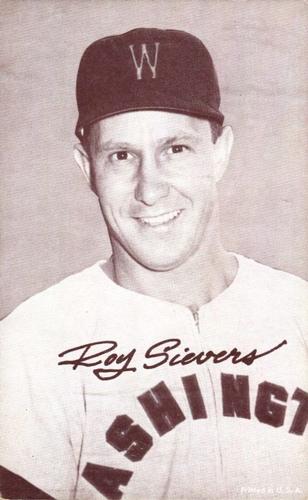September 2, 1954: Roy Sievers knocks in 7 as Senators rout Tigers
 “BLASTED!” yelled the box score.
“BLASTED!” yelled the box score.
“Senators Drub Tigers Again, 16-6,” lamented the sports page headline of the Detroit Free Press on September 3, 1954.1
Obviously, the Detroit scribes were miffed that the Tigers were soundly beaten by the Senators the day before, and to make matters worse, were swept in a three-game series in September, just as they had been in July. Tigers hurlers were racked for 18 hits in the massacre, three by Roy Sievers and three by All-Star Mickey Vernon. Sievers in particular hustled hard all season to show owner Clark Griffith and manager Bucky Harris that their new faith in him was not unfounded.
“Getting traded to Washington was the best thing that ever happened to me,” Sievers said in an interview. “Saved my career!”2
And that is exactly what Sievers did in D.C. in 1954.
After a fine 1949 Rookie of the Year season with the St. Louis Browns (.306 BA/16 HR/91 RBIs,) Sievers fell victim to a sophomore slump in 1950, hitting an anemic .238 with 10 homers and 57 RBIs. The slump continued into the 1951 campaign, so much so that he was sent down to the San Antonio Missions of the Texas League for “seasoning.” It was there on August 1 that he laid out to catch a low line drive, severely dislocating his right shoulder. Out for the rest of the season, Sievers tried rehabbing on his own, only to dislocate it again in spring training of 1952. Bill Veeck, the Browns new owner, arranged for Sievers to have a very experimental operation to fix the ailing shoulder. He wasn’t 100 percent in 1953 but managed a respectable .270 average with 8 homers and 35 RBIs in 92 games, basically hitting with one arm.3
Strapped for cash, Veeck was forced to sell the Browns and they moved to Baltimore in 1954. Word of Sievers’ busted wing, however, found its way into the hands of Baltimore manager Jimmy Dykes. Considering him “damaged goods,” Baltimore traded Sievers to the Senators for Gil Coan. It turned out to be one of Clark Griffith’s better trades.4
“When I come up to Washington, I asked [manager] Bucky Harris, ‘Where am I gonna play?’ I told him I still couldn’t throw too good, so’s I couldn’t play the outfield. He just said, ‘You get rid of the ball quick as you can. I need your bat in the lineup.’ So he put me in left field. Back then, I would just kind of loop the ball to the shortstop best as I could.”5
Nose to the grindstone, Sievers worked diligently to strengthen his arm, under the watchful eye of team doctor George Resta and trainer George “Doc” Lentz. His arm and bat showed great improvement. Playing nearly every game of the 1954 season, Sievers regained most of his power. Although his .232 batting average was subpar by his standards, he still managed 102 RBIs and hit 24 home runs into Griffith Stadium’s cavernous 388-foot power alley in left field. He was named Comeback Player of the Year by The Sporting News.6
On September 2 a meager gathering of 1,260 stalwart Senators fans twirled the Griffith Stadium turnstiles on a balmy, 80-degree Thursday afternoon to watch their Nats make history against the Tigers in the last of a three-game set. If the Senators had a patsy for the year, it was surely the Tigers: They beat Detroit 13 out of their 22 games. Led by veteran two-time AL batting champion Mickey Vernon, Eddie “The Walking Man” Yost, and Sievers, the ’54 Senators were a competitive team, despite ending up in sixth place, two games behind the Tigers.
The Senators’ Bob Porterfield faced off against the Tigers’ Ned Garver. Garver had his career year in 1951, going 20-12 for the hapless St. Louis Browns, where he teamed up with a very young Roy Sievers. Porterfield was coming off of a 22-10 season for the 1953 Senators.
The Tigers struck in the first inning. After Harvey Kuenn flied out, Fred Hatfield and Bob Nieman singled off Porterfield and Ray Boone’s fly ball scored Hatfield.
In the bottom of the inning, Yost drew a leadoff walk. Jim Busby flied out, then Vernon singled Yost to third. Sievers, hurting his former Browns teammate Garver, doubled Vernon and Yost home.
With his hit, Vernon became the 95th major leaguer and the ninth Senator with 2,000 hits, joining Joe Cronin, Joe Judge, Joe Kuhel, Heinie Manush, Clyde Milan, Sam Rice, Goose Goslin, and Ed Delahanty.7 Vernon finished 1954 with career highs in homers (20) and RBIs (97), and led the league with 33 doubles.
The second inning and the top of the third were harmless for Garver and Porterfield. The Senators half of the third was massive. After Yost and Busby singled, Vernon walked to fill the bases. Sievers’ double to center field cleared the bases and chased his pal Garver off the mound. Reliever Billy Hoeft fared no better, giving up a triple to Jim Lemon, scoring Sievers, and a double to Ed Fitz Gerald, scoring Lemon, before retiring the side with the Senators ahead 7-1.
The Tigers got two back in the top of the fourth with a triple by Chick King and a single by Hoeft. The Nats responded in kind in the bottom of the inning. Busby led off with his seventh homer of the year and Vernon singled. Sievers chased Hoeft with his 23rd home run of the season. Reliever Dick Marlowe gave up three hits and another run before retiring the side. The Senators were up 11-3.
Sievers’ home run broke the team home run record of 22, set by Zeke Bonura in 1938.
Other than Fred Hatfield’s single, the fifth inning was pretty much three up-three down for both sides. The Tigers plated a run in the sixth, making the score 11-4. In the bottom of the seventh, Yost singled Jerry Snyder home from second. Jim Busby reached on an error and Mickey Vernon cleared the bases with his 19th homer of the season, setting a team record for left-handed hitters, besting the likes of Goose Goslin, Stan Spence and Eddie Robinson. The Senators now led 15-4.
The Tigers went quietly in the eighth. The Senators plated one more in the eighth when Jerry Snyder singled to score Fitz Gerald. Porterfield gave up four hits and two runs in the top of the ninth, but finished the Senators’ 16-6 victory. Sievers ended his day with three hits, seven RBIs, and eight total bases.8
Sievers eventually set franchise home-run records in 1954 (24); 1955 (25); 1956 (29); and 1957 (42.) In 1957 he became the first player on a last-place team to lead the league in home runs, and had 114 RBIs and 331 total bases. He hit 39 homers in 1958 and 21 in 1959. In so doing, he set a Senators home-run record with 180, a figure that was bested by Frank Howard’s 237 during his years with the expansion Senators.9
From 1954 through 1959, Sievers’ prodigious home runs made him the Senatotrs’ biggest gate attraction since Walter Johnson, increased attendance by over 40 percent, and forced the forever parsimonious Calvin Griffith to rethink a proposed move to Los Angeles or Minnesota in 1957.
A five-time All-Star, Sievers ended his 17-year career with a .267 batting average, 1,703 hits, 318 home runs and 1,147 RBIs. He was only one of five players to hit pinch-hit grand slams in both leagues. (He had 10 grand slams in all.)
Mickey Vernon won a World Series ring as a player-coach for the Pittsburgh Pirates in 1960. A seven-time All-Star, he ended his 20-year career with a .286 batting average, 2,495 hits, 172 home runs and 1,311 RBIs. The two-time AL batting champion (1946, 1953) was the first manager of the expansion Washington Senators (1961-1963).
Sources
In addition to the sources cited in the Notes, the author accessed Retrosheet.org, Baseball-Reference.com, Newspapers.com, and SABR.org.
Notes
1 Hal Middlesworth, “Senators Drub Tigers Again, 16-6,” Detroit Free Press, September 3, 1954: 24.
2 Author interviews with Roy Sievers, by phone and in person, between 2014 and 2016.
3 Data compiled from Paul Scimonelli, Roy Sievers: “The Sweetest Right-Handed Swing” in 1950s Baseball (Jefferson, North Carolina, McFarland Inc. 2017).
4 Ibid.
5 Author interviews with Roy Sievers.
6 Bob Burns, “Highlights and Low Spots of ’54 Season,” The Sporting News, October 6, 1954: 12.
7 Bob Addie, “Nats Pound Tigers 16-6; Vernon hits ‘2000’ Goal,” Washington Post, September 3, 1954: 31.
8 Game details from baseball-reference.com/boxes/WS1/WS1195409020.shtml, Detroit News, Detroit Free Press, Washington Post and Washington Evening Star.
9 Sievers was traded to the White Sox in 1960 and also played for the Phillies. The Senators reacquired him in 1964 and he hit four more home runs, making his total with the team 184.
Additional Stats
Washington Senators 16
Detroit Tigers 6
Griffith Stadium
Washington, DC
Box Score + PBP:
Corrections? Additions?
If you can help us improve this game story, contact us.


